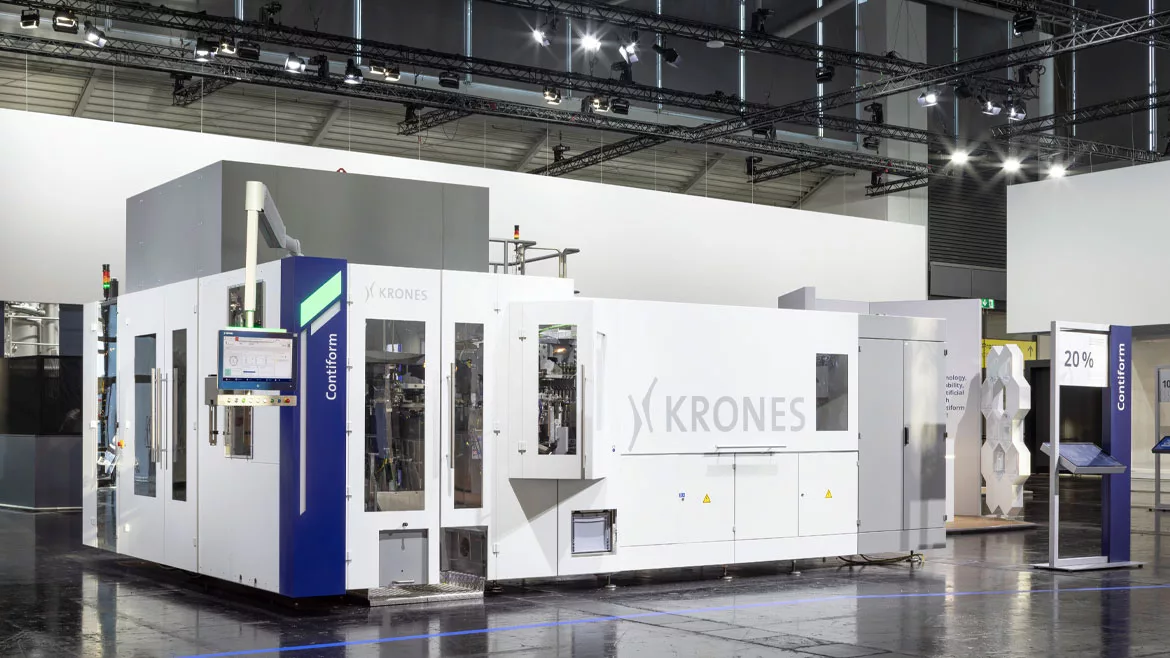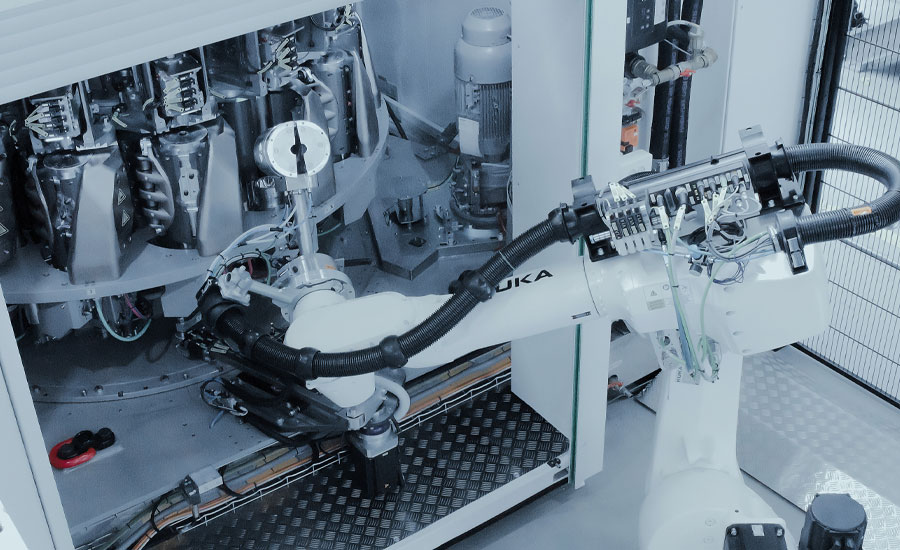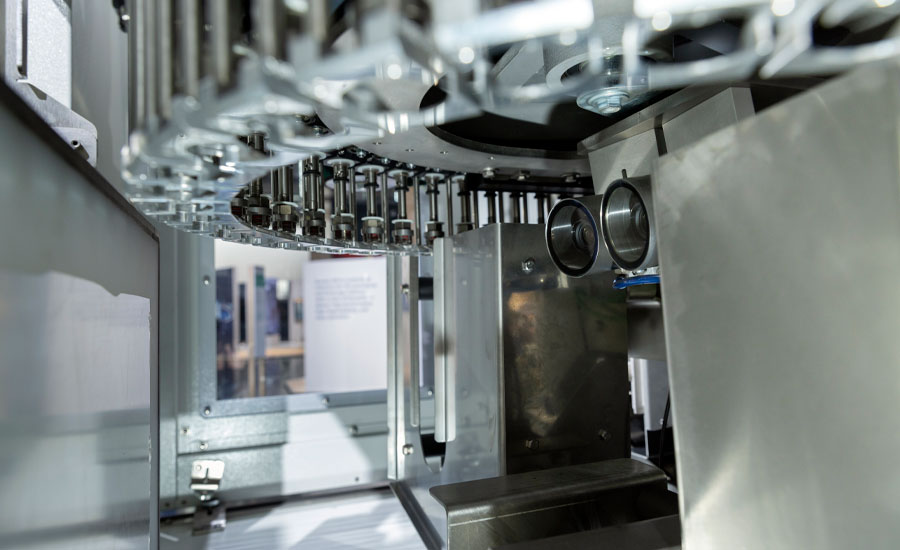Packaging Equipment
Plastic bottle manufacturing equipment addresses energy usage, diagnostics
Self-regulating practices minimize need for human intervention with preforms

Krones debuted Contiform Gen 4 at drinktec, a stretch blow molder that can even be equipped with artificial intelligence.
Image courtesy of Krones Inc.
In one of the Turtle Tips at the end of the “Teenage Mutant Ninja Turtles” animated series that aired during the late 1980s and early ’90s, Michelangelo opens the refrigerator to figure out what to eat. However, the other turtles inform him that he’s wasting electricity and energy that powers the appliance. Instead, the pizza-loving turtle thinks about what he wants to eat before opening the refrigerator, teaching kids watching at home a valuable lesson in conserving energy.
When it comes to beverage manufacturing and packaging practices, original equipment manufacturers (OEMs) are creating the machinery necessary to help beverage-makers conserve and reduce their energy output. For plastic bottle manufacturing, it’s not just the increasing adoption of recycled PET (rPET) plastic bottles, but also reducing the amount of carbon dioxide (CO2) that it takes to power these machines, experts note.
“Whether it be for the preforms and bottles or the equipment that makes them, modern machinery is having positive effect on the total CO2 reduction effort of OEMs and consumers alike,” says Bryan Lee, plastics technology sales for Krones Inc., Franklin, Wis.
Exemplifying this notion, Lee points to the company’s Contiform portfolio of high-performance blow molding machines.

Photo by Jörg Schwalfenberg/courtesy of KHS
“The Krones Contiform 3 family of machines specifically, focused on energy conservation with the introduction of servo technology, optimization of preform heating and increased usage of recycled air in the blowing process, which reduced air and energy consumption by nearly 35% over the previous generation,” he explains. “With new updates to the heating module and blowing process, the new Contiform Gen 4, which premiered at last month’s drinktec, by Krones takes that idea of energy conservation a few steps further to help our customers reduce their carbon footprint, reducing the overall consumption by an additional 15%.”
In line with sustainable manufacturing processes, more beverage brands are exploring the use of recycled content like rPET or even recycled high-density polyethylene (rHDPE). Before even addressing how manufacturing practices are adjusting to this variable, Lee notes that it’s important to discuss the quality of the incoming preforms.
“Krones AG has done extensive testing of different types of resins with up to 100% rPET material and studied the effect that it has during the heating process,” he says. “Results showed that while the blow molder is capable of handling these variations, quality control is paramount to success. In the past, customers with multiple preform sources would have a production recipe for each, meaning that they would constantly monitor what was going into the machine and react accordingly.”
Debuting a drinktec earlier this year, Krones unveiled the PET-View system, which is capable of 360-degree inspection to remove contaminated preforms, Lee says. The company also highlighted its new Contiloop AI, a self-regulating process that will adjust for different preform quality without human intervention.
“This allows the operator to focus on other tasks while the machine performs its own quality inspections and corrects the heating and blowing profiles as needed,” he explains.
Adjustments for success
Although sustainably conscious manufacturing practices are influencing the future of plastic bottle manufacturing, experts also highlight there have been some short-term shifts in terms of packaging materials.
“In 2020, we saw a spike in sales for can lines and a slight drop in PET, but we’ve rebounded in the last year with increased sales,” Lee says. “Recently we’ve seen glass manufacturing reduced as well, as more companies are changing their premium products from glass to PET in an effort to reduce weight and lower shipping costs. Aseptic technology in blow molding and filling also continues to advance, helping to replace the traditional hot-fill process and lower the associated operating costs.”
With these shifts, beverage manufacturers have many considerations to weigh when deciding the processing and packaging options before them.

Image courtesy of Krones Inc.
“There are several points to consider when purchasing a new production line including the types of products to be filled (water, carbonated drinks, juices, etc.), the filling process to be used (traditional, hot-fill or aseptic), and the bottling material you’ll be using,” Lee says. “That’s not to mention questions of budget, floor space, or sustainability efforts. Types of material to be used and the amount of recycled content also have an effect on bottle processing, so it is important to have a reliable source for raw materials.
“There are thousands of questions one might have when contemplating a new production line so it is important to have stable, reliable partners to help guide decision making,” he continues.
Beverage manufacturing operations also are seeing an increased need for packaging equipment to quickly adapt as plastic bottle sizes are not created in a one-size-fits-all mentality.
To support this need, KHS showcased at drinktec its InnoPET TriBlock stretch blow molder/labeler/filler to showcase how automated format changeovers can be successfully implemented. With the implementation of new KHS InnoPET iflex automation concept, beverage bottlers can save as much as 70% of the time needed for manual changeovers, according to the company.
In a press release, KHS explains that the most important new feature within the machine is the mold changeover. With the help of a robot, the two side mold shells and base molds are automatically and quickly swapped out during ongoing production.
“It removes the previous molds from the stations, places them in the mold set magazine, takes out the new molds and slots them back into the stations without any need for action from the operator,” the press release states. “The robot needs just 41 seconds per station for this short, fully reproducible procedure.”
Demand and supply
Further, the market for packaging equipment also is adjusting to limitations of the supply chain, particularly in regards to the technology implemented into these new systems, experts note.
“Lead times are considerably more than they were just one year ago, with the original impact being felt by a lack of electronic components,” Lee explains. “Today, we are even seeing extended lead times on fairly simple products like plate steel and aluminum blocks. Krones has responded by working with our customer base to plan further into the future on their upcoming projects. In fact, the impact of increasing shipping delays and rising fuel costs have made some customers more inclined to investigate self-manufacturing of their own preforms and bottles.”
Despite this impact, OEMs continue to innovate their plastic bottle manufacturing equipment to meet the growing needs of beverage-makers. Lee notes that advancements of the mechanical aspects remain cutting edge, but companies are turning improvements efforts to energy use reduction or diagnostics to the next generation of machinery.
“Refinements to servo technology continue to help reduce energy usage, while allowing for on-the-fly machine adjustments,” he says. “Cloud-based systems enable better communication between machines and line diagnostic systems, which benefits response time and remote troubleshooting when issues arise. All part of the Krones Ecosystem, Krones offers technology-based solutions designed to optimize production, improve sustainability, expedite support and reduce overall costs.”
As beverage manufacturers continue to utilize plastic packaging, it looks as though the machinery to produce these bottles is poised to improve on all aspects of this manufacturing process.
Looking for a reprint of this article?
From high-res PDFs to custom plaques, order your copy today!






